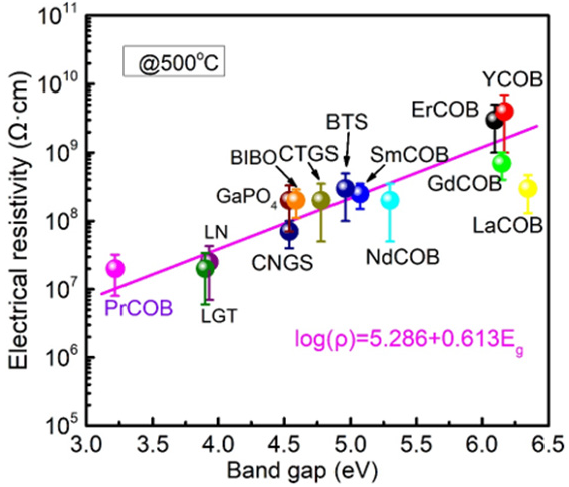- Submissions

Full Text
Aspects in Mining & Mineral Science
Relationship Between the Electrical Resistivity and the Band Gap for High-Temperature Piezoelectric Crystals
Shiwei Tian, Fapeng Yu* and Xian Zhao
Institute of Crystal Materials, Center for Optics Research and Engineering, Shandong University, P.R. China
*Corresponding author: Fapeng Yu, Institute of Crystal Materials, Center for Optics Research and Engineering, Shandong University, Jinan 250100, P.R. China
Submission: December 30, 2019;Published: November 10, 2021

ISSN 2578-0255Volume7 Issue5
Abstract
The electrical resistivity of piezoelectric crystals is a critical parameter for designing piezoelectric sensors working at elevated temperatures. In this report, the electrical resistivity as a function of band gap for different piezoelectric crystals is discussed and the potential relationship is presented.
Keywords: Piezoelectricity; Electrical resistivity; Electronic structure; Band gap; Sensor
Introduction
As a basic and critical parameter, the electrical resistivity of piezoelectric crystal determines the lowest usable frequency for piezoelectric sensors [1]. The electrical conduction of piezoelectric material is a complex process. It is known that the electrical conductivity (inverse of electrical resistivity) is dominated by the carriers, which are contributed from different factors, including ion migration, electron transition and micro crystal defects [2]. Considering the fact that the electrons motivated from the valence band to the conduction band contributes to the electrical conduction, the electrical conduction of piezoelectric crystals is believed to be associated with the band gap at elevated temperatures. To confirm this opinion, the electrical resistivities and electronic structures of high temperature piezoelectric crystals are studied comparatively.
Experiments
Different high-temperature piezoelectric crystals are selected for this study, including LiNbO3 (LN), La3Ga5.5Ta0.5O14 (LGT), Ca3NbGa3Si2O14 (CNGS), Ca3TaGa3Si2O14 (CTGS), Ba2TiSi2O8 (BTS), α-BiB3O6 (BIBO), GaPO4, and ReCa4O(BO3)3 (ReCOB) crystals etc. The band gap values for different high-temperature piezoelectric crystals are evaluated based on the transmission spectra recorded at ambient temperature. The Y-cut crystal samples with dimensions of 10×10×1mm3 are prepared to evaluate the electrical resistivity ρ22. The electrical resistances are measured using a source meter (Keithley 2410C). The electrical resistivity is evaluated by equation (1)

where U, I, A and t are applied voltage, measured current, area and thickness of the samples, respectively.
Results and Discussion
Among the investigated high-temperature piezoelectric crystals, the YCOB crystal is found to possess the largest band gap Eg being on the order of 6.17eV, while GdCOB and PrCOB crystals show relatively lower Eg values, being around 6.15eV and 3.56eV, respectively. Interestingly, this sequence is in accordance with the electrical resistivity, which is determined to be ρYCOB>ρGdCOB>ρPrCOB, as can be seen in Figure 1. It is clear that the magnitude of the electrical resistivity shows a tendency with the band gap value for these high-temperature piezoelectric crystals. The variations of electrical resistivity (at 500 °C) as a function of band gap for other high-temperature piezoelectric crystals such as LN [3,4], LGT [5], CNGS, CTGS, BTS, BIBO [6,7], and GaPO4 crystals [8,9] also obey this tendency, which strongly confirms the conclusion that the resistivity of the high-temperature piezoelectric crystals is associated with their electronic structure, the band gap of the crystal materials. The relationship between the electrical resistivity and band gap is further presented by data analysis. It is found that the order of magnitude of electrical resistivity for the electrical resistivity of high-temperature piezoelectric crystals is associated with the band gap value Eg.
Figure 1: Electrical resistivity (at 500 °C) versus band gap for different high-temperature piezoelectric crystals.

Conclusion
The relationship between electrical resistivity and electronic structure for high-temperature piezoelectric crystals is studied and presented. The electrical resistivity is obtained to be associated with the band gap of piezoelectric crystals. It can be predicted that the piezoelectric crystals with large band gap values possess high electrical resistivity at elevated temperatures. This study is significant for designing and/or selecting piezoelectric crystals for high-temperature piezoelectric applications.
Acknowledgment
This work was supported by the National Natural Science Foundation of China (Grant No. 51872165), and The Primary Research & Development Plan of Shandong Province (2017CXGC0413).
References
- Zhang SJ, Yu FP (2011) Piezoelectric materials for high temperature sensors. J Am Ceram Soc 94(10): 3153-3170.
- Domoroshchina E, Dubovskii A, Kuzmicheva G, Semenkovich G (2005) Influence of point defects on the electrical conductivity and dielectric properties of langasite. Inorg Mater 41: 1218-1221.
- Bhatt R, Ganesamoorthy S, Bhaumik I, Karnal AK, Gupta PK (2012) Optical bandgap and electrical conductivity studies on near stoichiometric LiNbO3 crystals prepared by VTE process. J Phys Chem Solids 73(2): 257-261.
- Bhatt R, Bhaumik I, Ganseamoorthy S, Karnal AK, Swami MK, et al. (2012) Urbach tail and bandgap analysis in near stoichiometric LiNbO3 Phys Status Solidi A 209(1): 176-180.
- Kong H, Wang J, Zhang H, Yin X, Cheng X, et al. (2004) Growth and characterization of La3Ga5Ta0.5O14 crystal. Cryst Res Technol 39: 686.
- Wang ZP, Teng B, Fu K, Xu X, Song R, et al. (2002) Efficient second harmonic generation of pulsed laser radiation in BiB3O6 (BIBO) crystal with different phase matching directions. Opt Commun 202: 217.
- Yu FP, Lu QM, Zhang SJ, Wang HW, Cheng XF, et al. (2014) High-performance, high-temperature piezoelectric BiB3O6 J Mater Chem C 3: 329-338.
- Trukhin AN (1997) Self-trapped excitations in SiO2, GeO2, Li2GeO3, AlPO4 and GaPO4. Mater Sci Forum 531: 239-241.
- Worsch PM, Krempl PW, Wallnofer W (2002) GaPO4 crystals for sensor applications. Sensors 589.
© 2021 Fapeng Yu. This is an open access article distributed under the terms of the Creative Commons Attribution License , which permits unrestricted use, distribution, and build upon your work non-commercially.
 a Creative Commons Attribution 4.0 International License. Based on a work at www.crimsonpublishers.com.
Best viewed in
a Creative Commons Attribution 4.0 International License. Based on a work at www.crimsonpublishers.com.
Best viewed in 







.jpg)






























 Editorial Board Registrations
Editorial Board Registrations Submit your Article
Submit your Article Refer a Friend
Refer a Friend Advertise With Us
Advertise With Us
.jpg)






.jpg)














.bmp)
.jpg)
.png)
.jpg)










.jpg)






.png)

.png)



.png)






